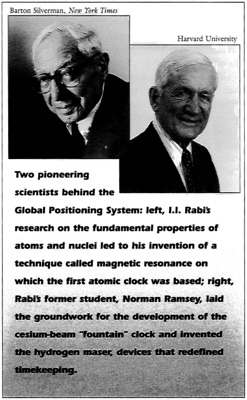only way to make measurements this accurate was to control a clock by the infinitesimal oscillations of the atom itself.
Rabi's Clock
According to the laws of quantum physics, atoms absorb or emit electromagnetic energy in discrete amounts that correspond to the differences in energy between the different electronic configurations of the atoms, i.e., different configurations of the electrons surrounding their nuclei. When an atom undergoes a transition from one such “energy state” to a lower one—it emits an electromagnetic wave of a discrete characteristic frequency, known as the resonant frequency. These resonant frequencies are identical for every atom of a given type—cesium 133 atoms, for example, all have a resonant frequency of exactly 9,192,631,770 cycles per second. For this reason, the cesium atom can be used as a metronome with which to keep extraordinarily precise time.
The first substantial progress toward developing clocks based on such an atomic timekeeper was achieved in the 1930s at a Columbia University laboratory in which I.I. Rabi and his students studied the fundamental properties of atoms and nuclei. In the course of his research, Rabi invented the technique known as magnetic resonance, by which he could measure the natural resonant frequencies of atoms. Rabi won the 1944 Nobel Prize for his work. It was in that year that he first suggested—“tossed off the idea,” as his students put it—that the precision of these resonances are so great that they could be used to make a clock of extraordinary accuracy. In particular, he proposed using the frequencies of what are known as “hyperfine transitions” of the atoms—transitions between two states of slightly different energy corresponding to different magnetic interactions between the nucleus of an atom and its electrons.
In such a clock, a beam of atoms in one particular hyperfine state passes through an oscillating electromagnetic field. The closer the oscillation frequency of that field to the frequency of the hyperfine transition of the atom, the more atoms absorb energy from the field and thereby undergo a transition from the original hyperfine state to another one. A feedback loop adjusts the frequency of the oscillating field until virtually all the atoms make the transition. An atomic clock uses the frequency of the oscillating field—now perfectly in step with the precise resonant frequency of the atoms—as a metronome to generate time pulses.

Rabi himself never pursued the development of such a clock, but other researchers went on to improve on the idea and perfect the technology. In 1949, for instance, research by Rabi's student Norman Ramsey suggested that making the atoms pass twice through the oscillating electromagnetic field could result in a much more accurate clock. In 1989 Ramsey was awarded the Nobel Prize for his work.
Practical Applications
After the war, the U.S. National Bureau of Standards and the British National Physical Laboratory both set out to create atomic-time standards based on the atomic-resonance work of Rabi and his students. The first atomic clock was established at the National Physical Laboratory by Louis

